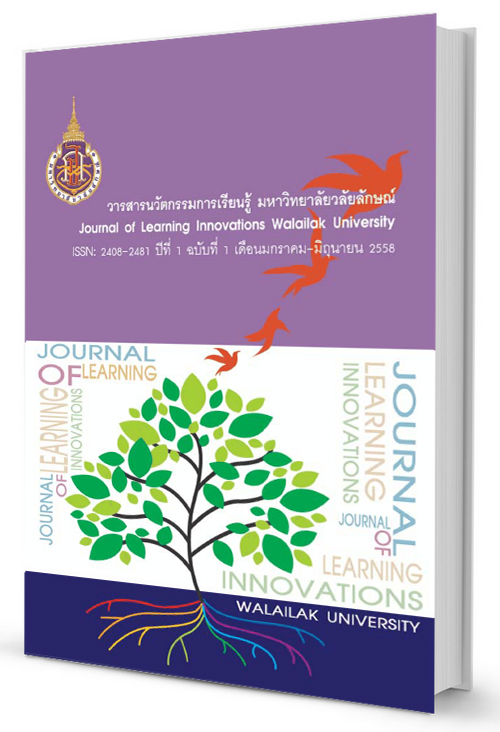Using Model-Based Learning for Enhancing Mental Model of Atomic Structure and Understandings of the Nature of Model of 10th Grade Students
DOI:
https://doi.org/10.14456/jli.2015.7Keywords:
การจัดการเรียนรู้โดยใช้แบบจำลองเป็นฐาน, แบบจำลองทางความคิด, ความเข้าใจธรรมชาติของแบบจำลอง, โครงสร้างอะตอม, Model-Based Learning, Mental Model, Understanding of the Nature of model, Atomic StructureAbstract
การวิจัยเชิงปฏิบัติการในชั้นเรียนนี้มีจุดประสงค์เพื่อศึกษาลักษณะการจัด กิจกรรมการเรียนรู้โดยใช้แบบจำลองเป็นฐานที่สามารถส่งเสริมแบบจำลองทาง ความคิดเรื่องโครงสร้างอะตอมและความเข้าใจธรรมชาติของแบบจำลองของนักเรียน ชั้นมัธยมศึกษาปีที่ 4 จำนวน 26 คน ของโรงเรียนมัธยมศึกษาขนาดกลางแห่งหนึ่ง ทางภาคใต้ ดำเนินการจัดการเรียนรู้ในภาคเรียนที่ 1 ปีการศึกษา 2556 เก็บข้อมูล เชิงลึกโดยใช้แบบวัดแบบจำลองทางความคิดเรื่องโครงสร้างอะตอม แบบวัดความเข้าใจ ธรรมชาติของแบบจำลอง อนุทินสะท้อนความคิดของนักเรียนและบันทึกหลังสอน ของผู้วิจัยซึ่งทำหน้าที่เป็นครูผู้สอน วิเคราะห์ข้อมูลเกี่ยวกับการจัดกิจกรรมการเรียนรู้ โดยการตีความและสร้างข้อสรุปแบบอุปนัย ผลจากการศึกษาพบว่า เมื่อนักเรียนได้เรียนรู้จากการจัดกิจกรรมการเรียนรู้โดยใช้แบบจำลองเป็นฐาน นักเรียนส่วนใหญ่มี แบบจำลองทางความคิดที่ถูกต้องและสอดคล้องกับแบบจำลองทางวิทยาศาสตร์และ มีความเข้าใจเกี่ยวกับธรรมชาติของแบบจำลองอยู่ในกลุ่มที่สอดคล้องกับแนวคิดที่ นักวิทยาศาสตร์ยอมรับเพิ่มขึ้นในทุกประเด็นที่ศึกษา โดยลักษณะการจัดกิจกรรม การเรียนรู้โดยใช้แบบจำลองเป็นฐานในเรื่องโครงสร้างอะตอมมีการสร้างสถานการณ์ ที่น่าสนใจเพื่อกระตุ้นให้นักเรียนสร้างแบบจำลองทางความคิด ร่วมกับการใช้คำถาม เพื่อตรวจสอบความรู้เดิม รวมไปถึงมีการใช้สื่อการเรียนรู้ที่เน้นให้นักเรียนเชื่อมโยง เนื้อหาเคมีทั้ง 3 ระดับ (ระดับมหภาค จุลภาค และสัญลักษณ์) สำหรับในแนวคิดที่เป็น นามธรรมมีการใช้กิจกรรมอุปมาในการจัดการเรียนรู้ และมีการสอดแทรกกิจกรรม ที่สะท้อนธรรมชาติของแบบจำลองร่วมกับการอภิปรายจุดเด่นและข้อจำกัดของ แบบจำลองเพื่อให้นักเรียนเข้าใจธรรมชาติของแบบจำลองและนำไปสู่ความเข้าใจ ธรรมชาติของวิทยาศาสตร์
Using Model-Based Learning for Enhancing Mental Model of Atomic Structure and Understandings of the Nature of Model of 10th Grade Students
This classroom action research was aimed to investigate how model-based learning activities in the topic of atomic structure enhanced high school students’ mental models and their understandings of the nature of model (NOM). The participants were 26 tenth grade students from a secondary school in the first semester of 2013 academic year. Data were gathered by Atomic Mental Model Survey (AMMS), Understandings of NOM questionnaire, student journal writing and teacher reflective journals. Inductive process was used to analyze all data. The results indicated that the model-based learning activities could enhance students’ correct mental model and informed understandings of NOM. The learning process though model-based learning activities could encourage students to produce their mental models, challenge students with questions to investigate their prior knowledge. It was also found that learning media in the activities could help students to connect the three levels of chemistry (macroscopic, submicroscopic and symbolic levels) and analogy learning activities could be alternative ways for teaching the abstract concept like atomic structure. Discussion on the key features and scopes of model during model-based learning activities could reflect the nature of model.
References
ชัยยนต์ ศรีเชียงหา. (2553). การพัฒนาแนวคิดเรื่องสมดุลเคมีและเจตคติต่อวิชาเคมีของนักเรียนชั้นมัธยมศึกษาปีที่ 5 ด้วยกิจกรรมการจัดการเรียนรู้โดยแบนจำลองเปีนุฐาน (วิทยานิพนธ์ ปริญญาโท, มหาวิทยาลัยเกษตรศาสตร์).
ชาตรี ฝ่ายคำตา. (2551). แนวคิดทางเลือกของนักเรียนในวิชาเคมี. วารสารศึกษาศาสตร์ มหาวิทยาลัยสงขลานครินทร์ วิทยาเขตปัตตานี, 19(2), 10-28.
สถาบันส่งเสริมการสอนวิทยาศาสตร์และเทคโนโลยี. (2546). การจัดการเรียนรู้กลุ่ม วิทยาศาสตร์หลักสูตรการศึกษาพื้นฐาน. กรุงเทพฯ: สถาบันส่งเสริมการสอน วิทยาศาสตร์และเทคโนโลยี.
ศุภกาญจน์ รัดนกร.(2552).การศึกษาแบบจำลองทางความคิดและความเข้าใจธรรมชาติ ของแบบจำลองของนักเรียนระดับชั้นมัธยมศึกษาปีที 5 เรื่องกรด-เบส (วิทยานิพนธ์ปริญญาโท, มหาวิทยาลัยเกษตรศาสตร์)
ฮามีด๊ะ มูลอ. (2555). การพัฒนาแบบจำลองทางความคิดเรื่องกรด-เบสของนักเรียนชั้น มัธยมศึกษาปีที่5 ด้วยกิจกรรมการเรียนรู้โดยใช้แบบจำลองเป็นฐาน (วิทยานิพนธ์ปริญญาโท, มหาวิทยาลัยเกษตรศาสตร์)
Buckley, B.C.,J. D. Gobert, A. c. Kindfield, p. Horwiz, R. F.Tinker, B. Gerlits, บ. Wilensky,C.Dede, and J. Willett. (2004). Model-BasedTeachingand Learning With BioLogicaTM : What Do They Learn? How Do They Learn? How Do We Know?. Journal of Science Education and Technology, 13(1), 23-41.
Clement, J. (2000). Model based learning as a key research area for science education. International Journal of Science Education, 22(9), 1041-1053.
Coll, R. K. (1999). Learners’ mental models of chemical bonding. (Thesis of Doctor Degree). Curtin University of Technology.
Coll, R.K. (2006). Metaphorand Analogy in Science Education. Netherlands: Springer.
Coll, R.K., B. France, and I.Taylor. (2005). The role of models/and analogies in science education: Implications from research. International Journal of Science Education, 27(2), 183-198.
Gilbert, J. K.(2005).Visualization in scienceeducation. Netherlands: Springer.
Gilbert, J.K. and S.W. Ireton. (2003). Understanding Models in Earth and Space Science. Arlington: NSTA Press.
Grosslight, L., c. Unge, and E. Jay. (1991). Understanding models and their use in science: Conceptionsofm iddleand high schoolstudentsand experts. Journal of Research in Science Teaching, 28(9), 799-822.
Harrison, A. G. and D.F.Treagust. (1996). SecondaryStudents’Mental Models of Atoms and Molecules: Implications for Teaching Chemistry. Science Education, 80(5), 509-534.
Harrison, A. G. and D.F. Treagust. (2000). A typology of school science models. International Journal of Science Education, 22, 1011-1026.
Johnstone, A. H.(l 993).Thedevelopment of chemist ryteaching:Achanging response to a changing demand. Journal of Chemical Education, 70(9), 701-705.
Justi, R.s.and J. K. Gilbert. (2002). Modelling, teachers’ views on the nature of modeling, and implications for the education of modelers. International Journal of Science Education , 24(4), 369-387.
Lederman, N. G., F. Abd-El-Khalick, R. L. Bell and R.S. Schwartz. (2002). Views of Nature of Science Questionnaire: Toward Valid and Meaningful Assessment of Learners’ Conceptions of Nature of Science. Journal of Research in Science Teaching, 39(6), 497-521.
Downloads
How to Cite
Issue
Section
License
เนื้อหาและข้อมูลในบทความที่ลงตีพิมพ์ในวารสารนวัตกรรมการเรียนรู้ มหาวิทยาลัยวลัยลักษณ์ ถือเป็นข้อคิดเห็นและความรับผิดชอบของผู้เขียนบทความโดยตรง ซึ่งกองบรรณาธิการวารสาร ไม่จำเป็นต้องเห็นด้วย หรือร่วมรับผิดชอบใดๆ
บทความ ข้อมูล เนื้อหา รูปภาพ ฯลฯ ที่ได้รับการตีพิมพ์ในวารสารนวัตกรรมการเรียนรู้ มหาวิทยาลัยวลัยลักษณ์ ถือเป็นลิขสิทธิ์ของวารสารนวัตกรรมการเรียนรุ้ มหาวิทยาลัยวลัยลักษณ์ หากบุคคลหรือหน่วยงานใดต้องการนำทั้งหมดหรือส่วนหนึ่งส่วนใดไปเผยแพร่ต่อเพื่อกระทำการใดๆ จ้อต้องได้รับอนุญาตเป็นลายลักษณ์อักษรจากวารสารนวัตกรรมการเรียนรู้ มหาวิทยาลัยวลัยลักษณ์ก่อนเท่านั้น


